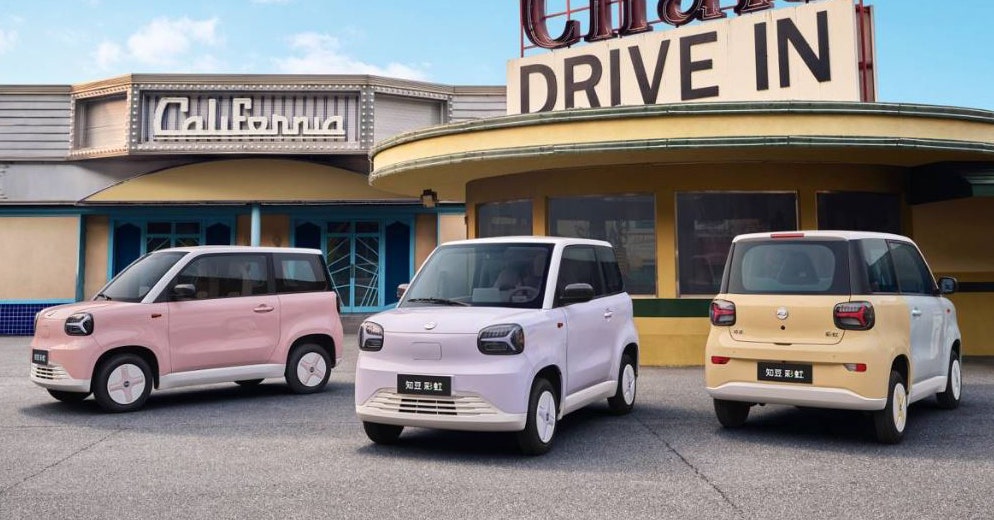The Zhidou Rainbow: An Affordable Electric Microcar Revolution
A Colorful and Compact Alternative
As Tesla moves away from the idea of producing a $25,000 car, and the Citroën Ami remains a flawed $10,000 option, the Zhidou Rainbow emerges as an intriguing alternative. Priced at just $4,400, this Chinese electric microcar is even cheaper than some high-end bicycles.
The Rainbow boasts three doors, four seats, and a surprisingly modern interior featuring a 5-inch digital driver display and a 9-inch touchscreen infotainment system. It even comes with a connected smartphone app, charge scheduling, and the promise of over-the-air (OTA) software updates. For those seeking a unique look, the flagship Color Cloud Edition ($5,800) allows each panel to be painted a different color, reminiscent of the quirky Volkswagen Polo Harlequin from the mid-’90s.
Modest Specs, but Impressive Value
The Rainbow is available in two models:
- The base model, priced at $4,400, is powered by a 20-kW (27-horsepower) motor with 85 Nm (63 ft-lbs) of torque and a 9.98-kWh battery.
- The higher-end model, priced at $5,500, features a 30-kW (40-horsepower) motor with 125 Nm of torque and a 17-kWh battery pack.
Range varies between 78 and 127 miles using China’s generous CLTC testing standard. While these numbers may seem small, the range is comparable to the now-discontinued Honda e, which cost a staggering £37,000 ($46,000).

Compact Dimensions and Global Potential
Measuring 3,224 mm (126.9 in) long, 1,515 mm (59.7 in) wide, and 1,630 mm (64.2 in) tall, the Rainbow is undeniably tiny by modern, Western standards. However, such small cars are not uncommon in other parts of the world. The Rainbow is larger than the iconic Mini and Fiat 500, and just slightly too wide to qualify as a “kei car” in Japan, where smaller vehicles enjoy tax, insurance, and parking benefits.
The idea of tiny, affordable electric cars has been explored for years, from Alec Issigonis’ groundbreaking Mini in the late 1950s to the short-lived Smart ForTwo Electric Drive. While larger vehicles have dominated the market, the desire for smaller, more efficient cars has persisted, particularly in Europe.

Zhidou’s Resurgence and Industry Partnerships
Zhidou, founded in 2006, has experienced a tumultuous journey. After releasing several small electric vehicles and even expanding into Europe through a car-sharing partnership in Italy, the company went bankrupt in 2019. However, a restructuring effort led by Geely and Aima Technology Group has brought Zhidou back to life.
Geely, a Chinese auto giant, owns or has stakes in several well-known brands, including Volvo, Lotus, LEVC (the maker of London’s electric taxis), Aston Martin, and Mercedes-Benz. Aima Technology Group, founded in 1999, is a Chinese manufacturer and seller of electric bicycles, mopeds, and motorbikes. The partnership between these two companies could lead to the Zhidou Rainbow appearing in Aima’s retail locations alongside their other electric vehicles.
The Future of Electric Microcars
While established car companies may not prioritize the microcar segment due to its lower value, limited performance, and inherent safety concerns, the success of the Rainbow and earlier attempts at electric microcars, such as the Murray T27 and the Smart ForTwo, suggest there is potential in this market, especially in densely populated, emerging markets.
New electric microcars are also being developed in the West by companies like New Electric in New York. Even Tesla might benefit from considering a more affordable city car or a Model 1 microcar, as CEO Elon Musk has hinted at in the past.
You could say that following the Rainbow might even lead Tesla to a pot of gold.

3 Comments
Elon’s pivot might be a deal-breaker for some, yet a $4,400 EV screams “revolution” in bold!
Elon’s dreams got too pricey, so now we’ve got a $4,400 EV? Talk about a plot twist!
Elon’s dreams come at a price, but $4,400 for an EV? Bargain of the century or a toy on wheels?